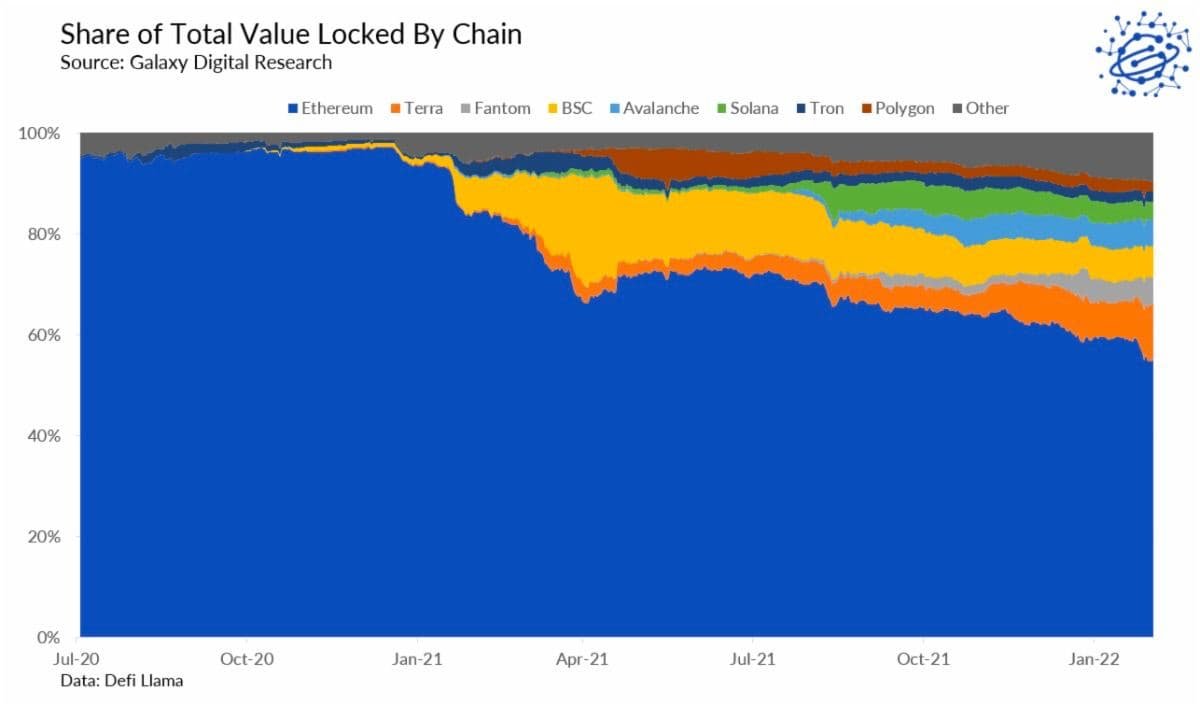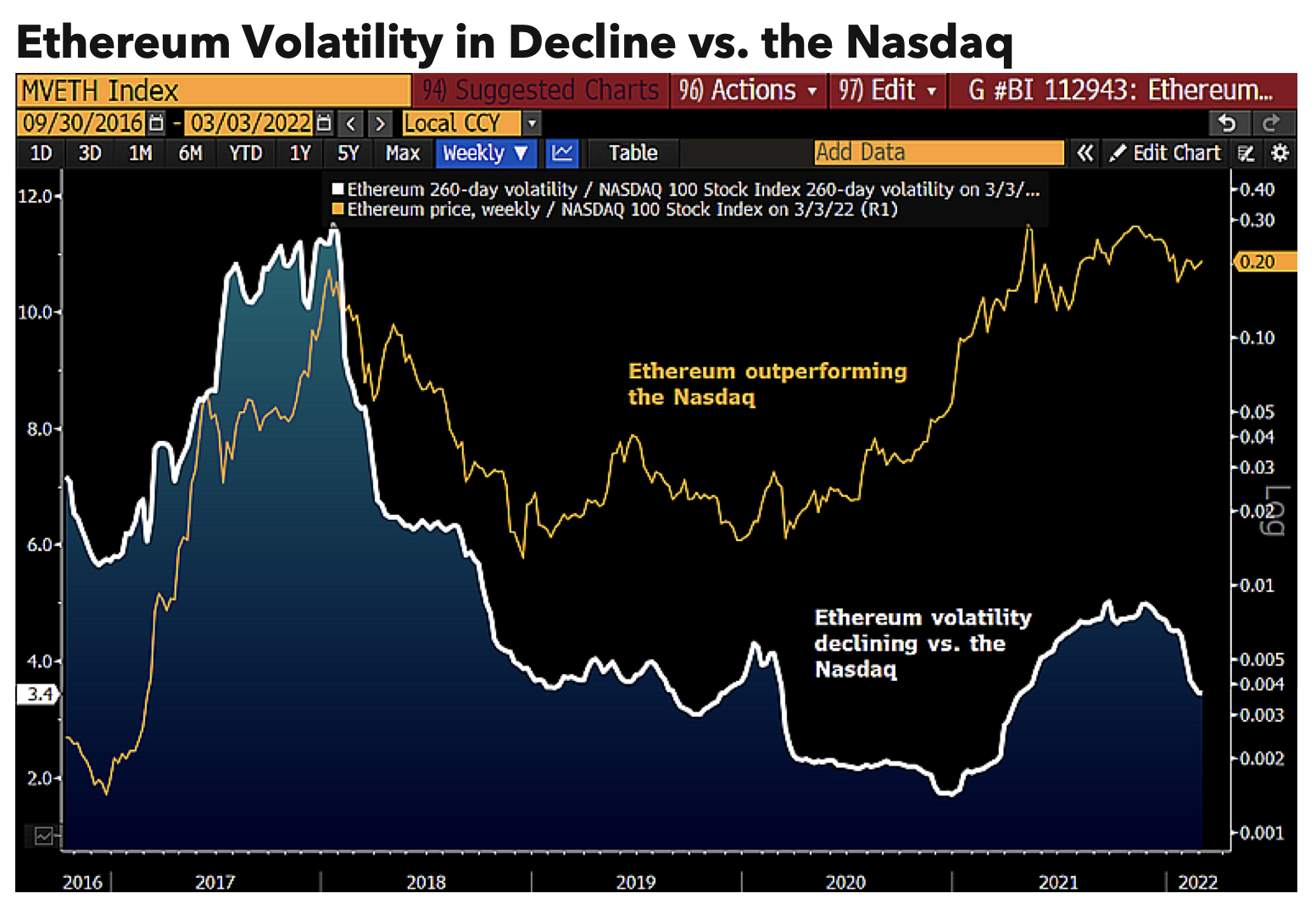Another big drop in the U.S. stock market could leave Ethereum’s native token Ether (ETH) in a similar downside spell, according to the latest Bloomberg report on digital assets.
Ethereum faces global recession risks
Mike McGlone, the senior commodity strategist at Bloomberg Intelligence, anticipates U.S. equities to face downside pressure against the prospects of the ongoing energy-price spikes and their ability to invoke a 2008-like global market recession
“The war in Ukraine and spiking crude make a potent combination for a global recession,” wrote McGlone in the report, adding that top cryptocurrencies like Bitcoin and Ether could also face initial pressures.

WTI crude oil weekly price chart. Source: TradingView
Correlations between U.S. stock indexes and top cryptocurrencies have only increased during the ongoing global market rout and Ukraine-Russia conflict.
In particular, Ether’s correlation efficiency with tech-heavy Nasdaq 100 rose to 0.93 four days after Russia invaded Ukraine but has since corrected to 0.67. An absolute value of 1 means the two assets move perfectly in tandem.

ETH/USD daily price chart featuring its correlation with Nasdaq 100. Source: TradingView
McGlone spotted Ether trading in the middle of a range defined by its 100-week exponential moving average (100-day EMA; the red wave in the chart below) near $6,000 and its 30-week EMA (the green wave) near $2,000. He also expects significant selling pressure at the interim resistance level of $4,000.

ETH/USD weekly price chart. Source: Bloomberg Intelligence
“Our graphic depicts Ethereum at about the middle of the range,” the strategist wrote, asserting that “if the stock market takes another leg lower, Ethereum is more likely to revisit the lower end” near $2,000. He added:
“If equities drop fast, Ethereum could repeat last summer and revisit about $1,700.”
Ethereum TVL share drops to record lows
The latest data shows that Ethereum’s market dominance is also giving up ground to competitors like Cardano (ADA), Solana (SOL), Avalanche (AVAX), and Terra (LUNA).
The share of the total value locked (TVL) on the Ethereum network declined below 55%, its lowest level on record, from 97% at the start of 2021, according to data from DeFi Llama.

Share of total value locked by chain. Source: Defi Llama, Galaxy Digital Research
Tom Dunleavy, a researcher at Messari, notes that new layer-one blockchains are comparatively “faster, cheaper, or provide a more attractive reward structure” than Ethereum.
Nonetheless, he adds that completely overtaking Ethereum and Ethereum Virtual Machine (EVM), a software platform to create decentralized applications (DApps), would be hard due to first-mover advantage.
“The EVM’s advantage has been so great that major competitors use or bridge to the EVM, rather than try to compete head-to-head without this capability,” Dunleavy wrote, adding:
“Even competitors that held out like Solana and Cardano have recently added or are adding EVM compatibility (Terra being the notable exception). In many cases, the EVM has already cemented itself through its network effects.”
But most of the so-called “Ethereum killers,” except Terra, have fared far worse so far in 2022 when faced with geopolitical conflicts, energy crises, and rate hike risks.
For instance, Solana and Cardano dropped by more than 50% year-to-date versus Ether’s 30% price decline. Avalanche price dropped by 37% in the same period.
Can Ethereum regain market share?
Not everyone expects Ethereum’s TVL market share downtrend to continue, however. Marcus Sotiriou, an analyst at GlobalBlock, anticipates Ethereum to regain its dominance as it switches to proof-of-stake later this year from its current proof-of-work protocol.
“This is because it should dramatically reduce the cost of transactions on the Ethereum network, which is currently Ethereum’s main drawback,” he told Business Insider earlier this month. As of now, Ethereum works on a surge-pricing model, leading to highly volatile transaction fees.
In August 2021, the network underwent a so-called “London hard fork” that employed a key EIP-1559 protocol. In particular, the EIP-1559 allows the Ethereum protocol to burn gas fees, meaning that a portion of Ether’s supply goes out of circulation permanently.
“Bitcoin and Ethereum remain in early adoption days, with increasing demand vs. declining supply and related price implications,” explained McGlone, adding:
“Our bias is why complicate it — unless something unlikely reverses the proliferation of the nascent technology, prices should rise.”
The strategist also anticipates that Ether’s correlation with the U.S. stock market will also decrease due to to so-called “declining relative risk.”

Ethereum volatility vs. the Nasdaq. Source: Bloomberg Intelligence
“Closer to 3x now, the relative risk of the nascent technology/asset is poised to keep falling, particularly if the war increases recession risks and stock market volatility,” he asserted.
Source: Cointelegraph









